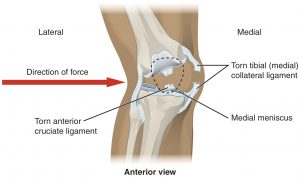A Meniscus Tear is a rupturing of one or more of the fibrocartilage strips in the knee called menisci. When doctors and patients refer to “torn cartilage” in the knee, they actually may be referring to an injury to a meniscus at the top of one of the tibiae. Menisci can be torn during innocuous activities such as walking or squatting. They can also be torn by traumatic force encountered in sports or other forms of physical exertion. The traumatic action is most often a twisting movement at the knee while the leg is bent.
In older adults, the meniscus can be damaged following prolonged ‘wear and tear’. Especially acute injuries (typically in younger, more active patients) can lead to displaced tears which can cause mechanical symptoms such as clicking, catching, or locking during motion of the joint. The joint will be in pain when in use, but when there is no load, the pain goes away.
It is important to know if there was trauma involved, the symptoms are new as well as the stability of the tear. A stable tear is much less likely to require surgery than an unstable tear. Knowing the heavy correlation between meniscus deficiency and osteoarthritis, doctors are doing everything they can to try and repair – or at least save some of the meniscus rather than removing it entirely.
Different types of meniscus tears are encountered, namely:
- Radial tear:
It is the most common tear, the damaged parts will be trimmed away. - Longitudinal tear:
Longitudinal tears can be sutured if it is in the red zone. - Horizontal tear:
In the case of a horizontal tear, the surgeon will try to sew the circumferential fibers together. - Incomplete tear:
if an incomplete tear is considered stable on a MRI scan an operation may not be necessary. - Complex tear:
A complex tear is where there are several tear patterns and the torn segments are removed. - Flap tear:
A Flap tear causes a catching sensation, resecting a small section can resolve the problem. - Degenerative tear:
A Degenerative tear usually occurs as a result of wear and tear and may need a partial meniscectomy. - Bucket handle tear:
A Bucket handle tear involves a large portion of the meniscus, the knee becomes “locked”, requires urgent surgery to try and save the meniscus. - Root tear:
A Root tear dislodges the end of the meniscus and makes the meniscus unstable, it could be degenerative or caused by trauma. Most root tears that occur in the setting of moderate to severe arthritis should not be fixed. Fixing a medial meniscus root tear might slow the progression of osteoarthritis. When a root tear is accompanied by an ACL tear both should be fixed at the same time. - Ramp tear:
A Ramp tear is a longitudinal peripheral lesion of the posterior medial meniscus or meniscocapsular junction, previously called a ‘hidden lesion’. Ramp tears are mostly associated with ACL tears and their diagnosis requires a high index of suspicion Posteromedial tibial bone bruising was found to be an important secondary MRI finding of ramp lesions. The treatment alternatives are reported as non-operative, inside-out repair, and all inside repair. Currently, the optimal management and technique regarding meniscal repair in root tears and ramp lesions is still evolving and remains debatable and controversial.


